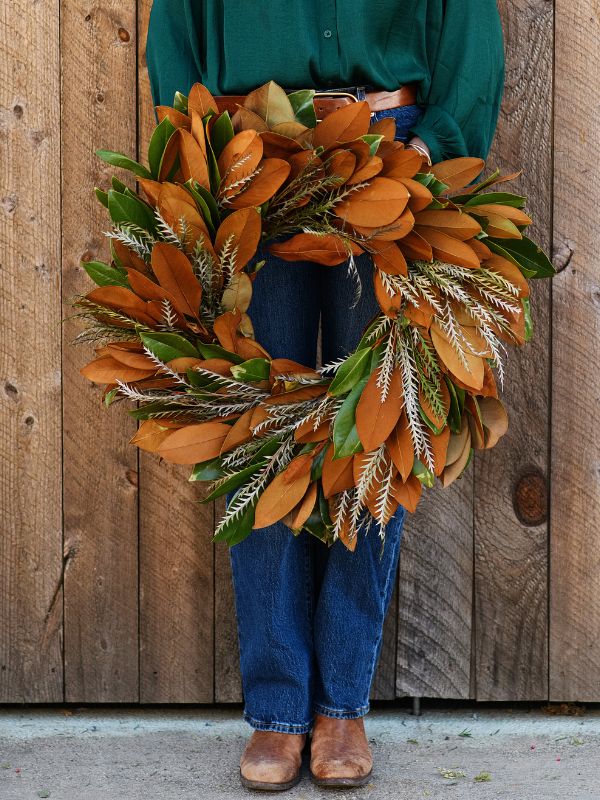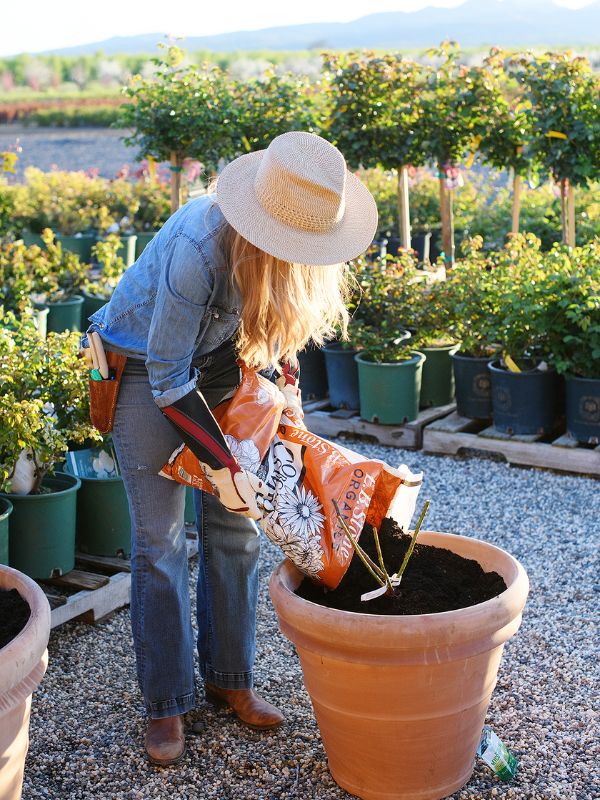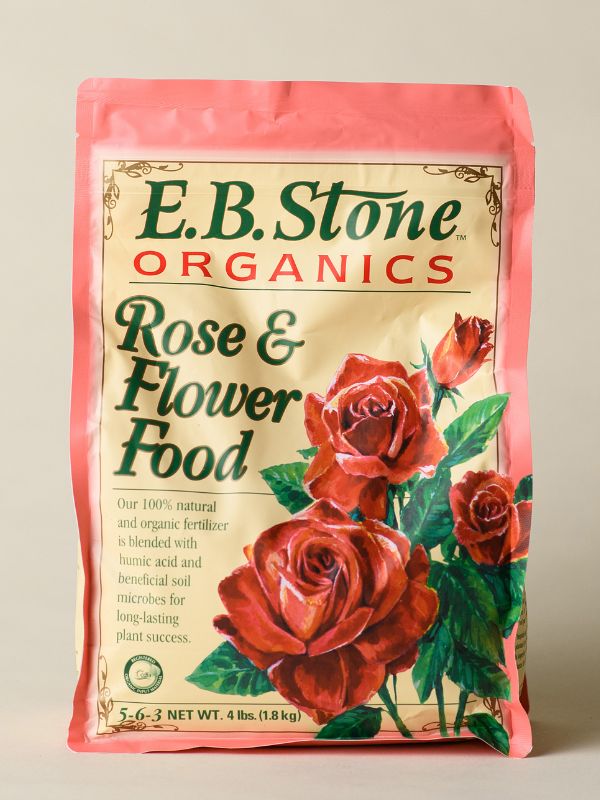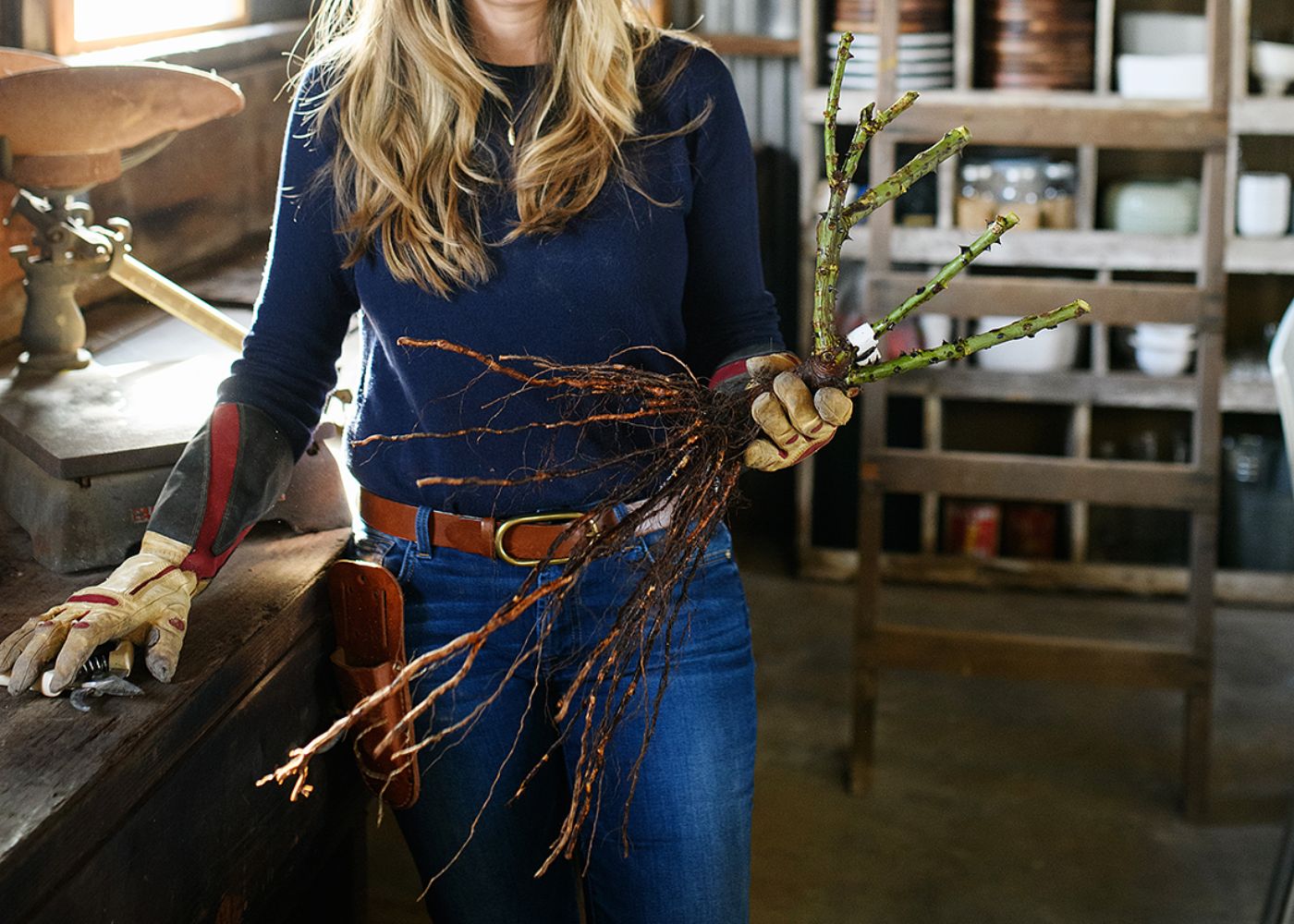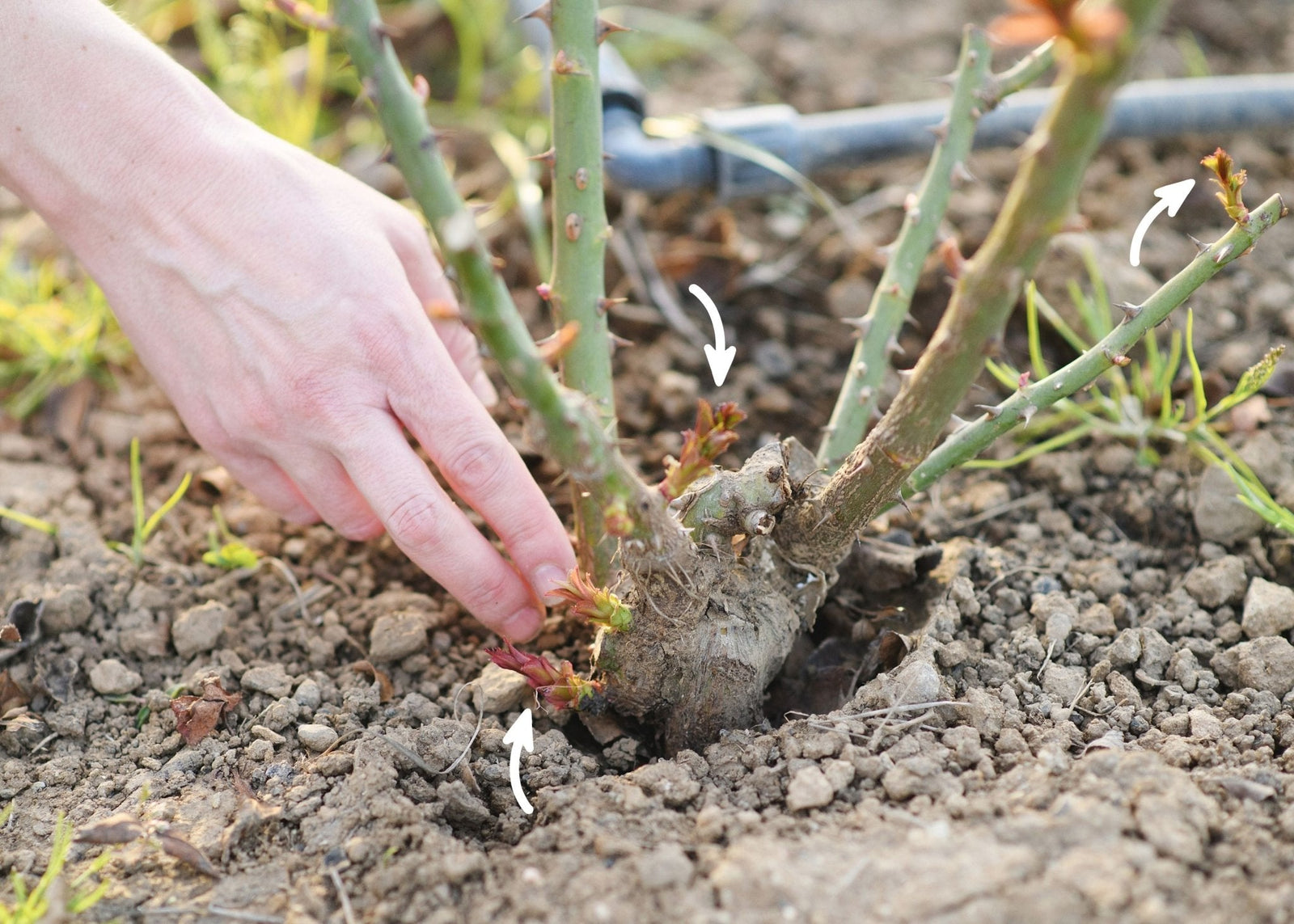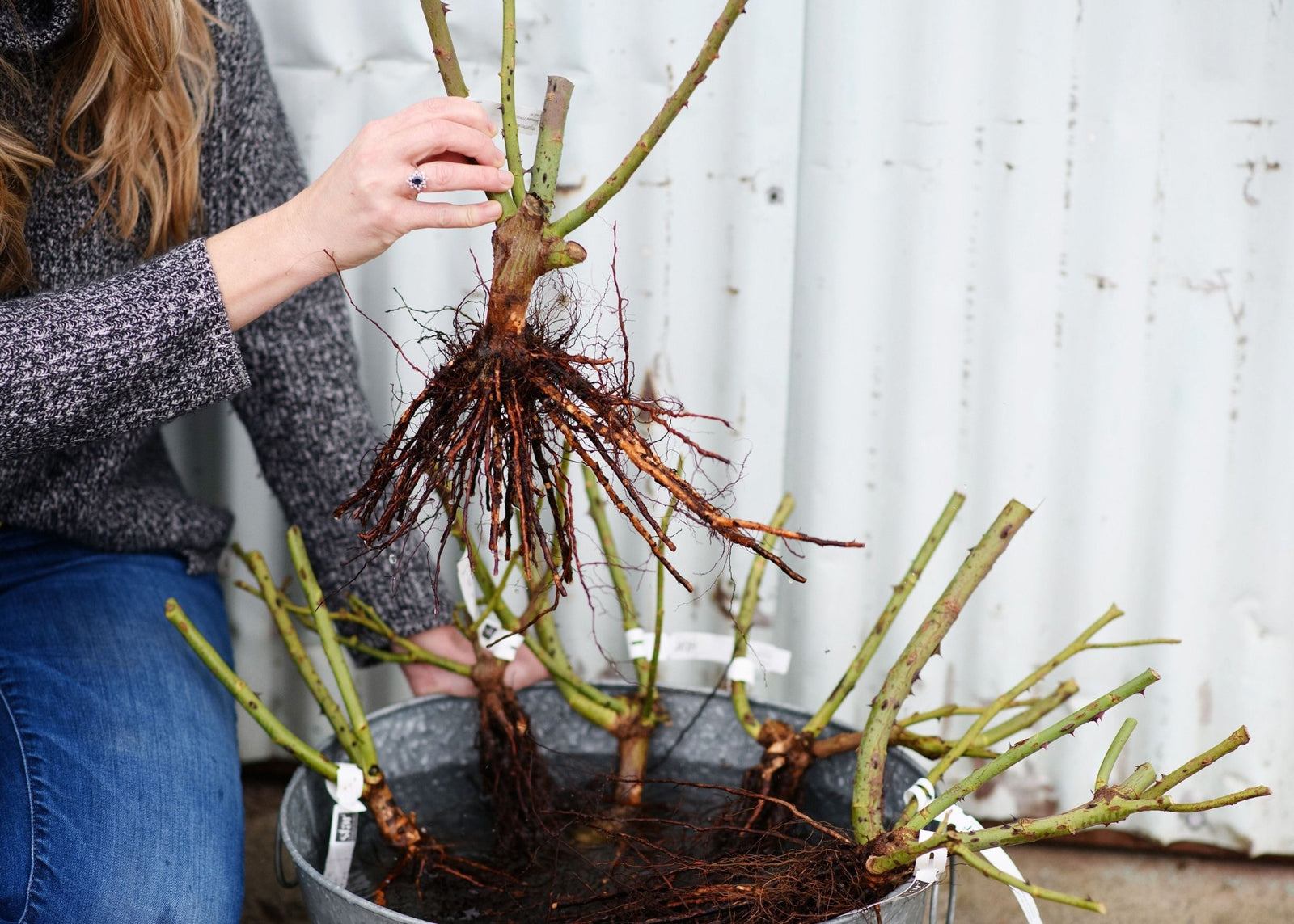
WHAT IS A ROSE GRADE?
A rose grade indicates the size of the rose when it’s harvested from the growing field and reflects the number of canes a rose must have, the size of the canes and where on the plant measurements are taken. Over 50 years ago, the American Association of Nurserymen—in association with the American National Standards Institute (ANSI)—developed grading standards for grafted, field-grown garden roses in the United States to standardize the quality of rose sizes sold.You can read more on the American Standards for Nursery Stock here.

Pictured: Grade 1.5 grafted rose on the left and grade 1 grafted rose on the right.
WHAT IS THE DIFFERENCE BETWEEN GRADE 1, GRADE 1.5, AND GRADE 2 GRAFTED ROSES?

Two Grade 1 own root roses of different varieties. On the left is a variety with thicker taller straight canes. On the right a rose that has naturally smaller branching canes and a more petite spread. Both are Grade 1 own root plants using the ANSI grading standards.
WHY IS MY OWN ROOT GRADE 1 ROSE SMALLER THAN MY GRAFTED GRADE 1 ROSE?
Grafted roses are typically larger in size than own root roses. Roses of the same variety can be labeled Grade 1 while also being physically different sizes. This happens for two reasons - first, grafted bare root roses are 2 year old plants and own root bare root roses are 1 to 1.5 year old plants. The older the plant usually the larger the size because it's been given more growing time before it's harvested. Second, because the standardized ANSI grading system is different for grafted rose and own root rose categories. Own root roses are graded in the "deciduous shrubs" category (section 3) and not as roses in the "roses" category (section 6) using the ANSI grading standards and may have canes that are smaller than their grafted rose siblings of the same grade. They do not have the same requirements for cane diameter or height as grafted roses. Grade 1 own root roses from our collection will have a minimum of three canes with no specified diameter or height measurement. Bare root roses that are imported from Canada or other countries also may be labeled as Grade 1, but look smaller in size than their U.S. counterparts because the grading standards are different.
Grade 1 own root roses of different varieties can also be different sizes. Just like the body shape & size of people vary so do the sizes of roses. Some people have longer torsos and shorter legs or longer arms and feet but I would argue we are all Grade 1 humans, we just come in different shapes & sizes that make us all unique. Some roses have longer canes with a wider spread. Some have thinner canes with more thorns. Some are taller and some are broader. The size of a bare root rose, will reflect the individual characteristics of the rose variety. This is one area of rose growing where size doesn’t always matter as a bare root roses that is "smaller" will grow to be full size roses just like their "larger" counterparts.
What’s important is looking for the grade number, whether it’s grafted or own root, and U.S.-produced or imported. If you are purchasing your rose from a reputable nursery then they have graded the rose appropriately using the ANSI grading system. Personally, I think this is one area of the standardization system that could use a revision after 50 years with so many more rose varieties now available in own root selections. The current grading standards for the "deciduous shrubs" category only outlines the requirements for what the plant needs to look like as a finished container size after one year of growth and not as a bare root plant. Here is an excerpt directly from the standards of Section 3.1.2 Specifications for Type 0 tender deciduous shrubs (aka own root roses): "Plants may not meet plant size specification or minimum number of canes at time of shipment at certain times of the year, but would be expected to reach the plant size specification and minimum number of canes during the first growing season after shipment. In cases where plants may be shipped after being pruned back and before reaching plant size specification, specifications shall also include minimum spread of roots. Specifications for Type 0 tender deciduous shrubs may include only the container size."WOW! This is enough mumbo jumbo to even make my head spin and I'm in the nursery trade!
When the grading standardization was developed, the market was almost exclusively grafted roses. It's also important to keep in mind that the grading standardization for both grafted and own root roses was developed for those in the professional nursery trade, not retail consumers, purchasing bare root roses and placing them in pots (aka canning) for sale as fully finished leafed out plants for consumers to buy in retail nursery centers. It can make it very confusing for both new & veteran gardeners alike when they receive an order of bare root roses of both grafted and own root rose plants that are all Grade 1 by ANSI standards and the plants all are different shapes and sizes. It's easy to assume the smaller own root plants to be inferior quality when in-fact they are equal to or better than their grafted siblings.
When ordering a bare root rose, you are purchasing the same thing a professional nursery would buy, place in a pot, tend to it letting it get bigger with more cane and root growth and then selling it 4-6 months later in a garden center come springtime. You get to do all of that TLC in your garden while getting a rose that's a fraction of the price of a potted finished rose.
WHICH ROSE GRADE SHOULD I CHOOSE?

With so many factors to consider when purchasing bare root roses, I hope these rose grade tips help you make the right choice for your garden!



